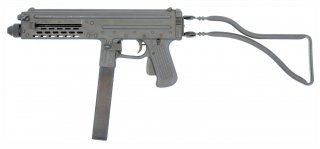Italy’s Franchi Only Made One Submachine Gun – Meet the LF-57
Perhaps it was a case of trying to beat a competitor to the market but when it was introduced, the pressed-metal submachine was a solution to a problem that didn’t exist.
Since being founded in 1868 the Italian gun manufacturer Luigi Franchi S.p.A. produced a series of shotguns and rifles and while the company never reached the level of Beretta in terms of international acclaim, the family-owned firm was known for quality and reliability.
In more than 150 years in operation, Franchi only produced a single submachine gun, and while far from the worst one ever created it is easy to see why the company returned to what it knew best and left the military SMGs to other companies.
For reasons that aren’t clear Franchi developed the compact submachine gun in 1956 and the first prototype, designated the LF-56, attracted little interest from the Italian military. However, the company pressed on, refined the design and introduced the LF-57 a year later. It was similar in design to a prototype being developed by then-rival Beretta, which would go on to be the Model 12.
Perhaps it was a case of trying to beat a competitor to the market but when it was introduced, the pressed-metal submachine was a solution to a problem that didn’t exist. The Italian Army had adopted the Model 12, and only the Italian Navy expressed interest in the LF-57 and even then sales weren’t exactly robust.
The FL-57 was really a victim of a saturated market that included not only the Model 12 but also from the Belgian Vigneron, the German Heckler & Koch MP5, the Israeli Uzi and the British Sterling to name a few. There were also plenty of Communist Bloc weapons that were also being supplied to revolutionaries and insurgents around the globe in the 1960s so by the time the LF-57 entered production it was facing intense competition.
Not a Bad Gun
The truth was that the 9x19-millimeter Parabellum submachine gun, which was in fact compact at only 16.5 inches with its wire stock folded and only twenty-seven-inches with it extended, was actually a reliable weapon. It was a typical blowback-operated submachine gun that fired from an open bolt, and initially was full-automatic only. It weighed a manageable seven pounds and had a respective rate of fire of five hundred rounds per minute and an effective range of about twenty-five meters.
A second version, known as the Police Model featured an extended barrel and was available in semiautomatic. As the name suggested it was offered for sale to police departments around the world while sources suggest it was also offered commercially.
However, this reporter can attest that in three decades of going to gun shows around the country since the age of twelve I’ve never seen one of the commercial versions for sale and never have encountered a collector who even claims to have owned or seen one! Moreover, the only ones that have shown up for sale are the fully-automatic ones that require an ATF transfer to legally purchase. Thus it is likely that Franchi never found a disrupter for those commercial versions in the United States but perhaps someone out there knows better.
It also seems that apart from the Italian Navy that the most interested buyers were newly independent nations in Africa including Angola, Mozambique, Nigeria and Zaire. Period photos suggest that the weapon was used by some mercenary forces in Africa during some of the African wars, notably in the Congo.
Production of the LF-57 ended in 1980 and it is unknown exactly how many were manufactured over the course of twenty-three years. Unlike other firearms of the era that had their moment in the spotlight in movies and on TV, the most famous use of the LF-57 was likely in the 1990 film Total Recall when it was used by the dwarf hooker character “Thumbelina” in the film’s climactic shootout.
Perhaps with marketing like that Franchi could have sold more of this largely forgotten Italian submachine gun.
Peter Suciu is a Michigan-based writer who has contributed to more than four dozen magazines, newspapers and websites. He is the author of several books on military headgear including A Gallery of Military Headdress, which is available on Amazon.com.
Image: Reuters

